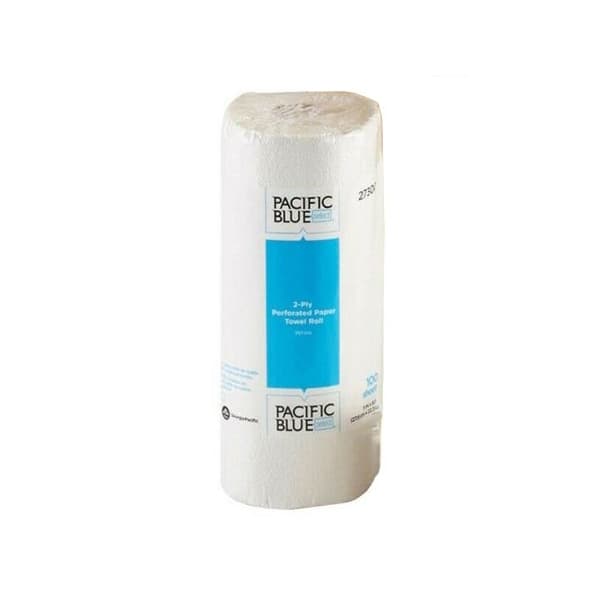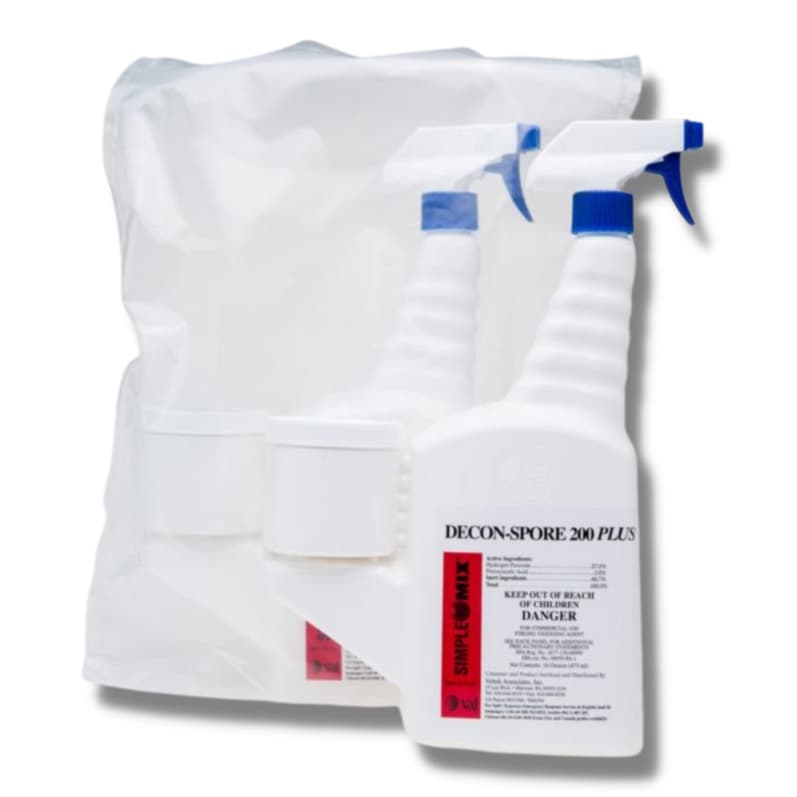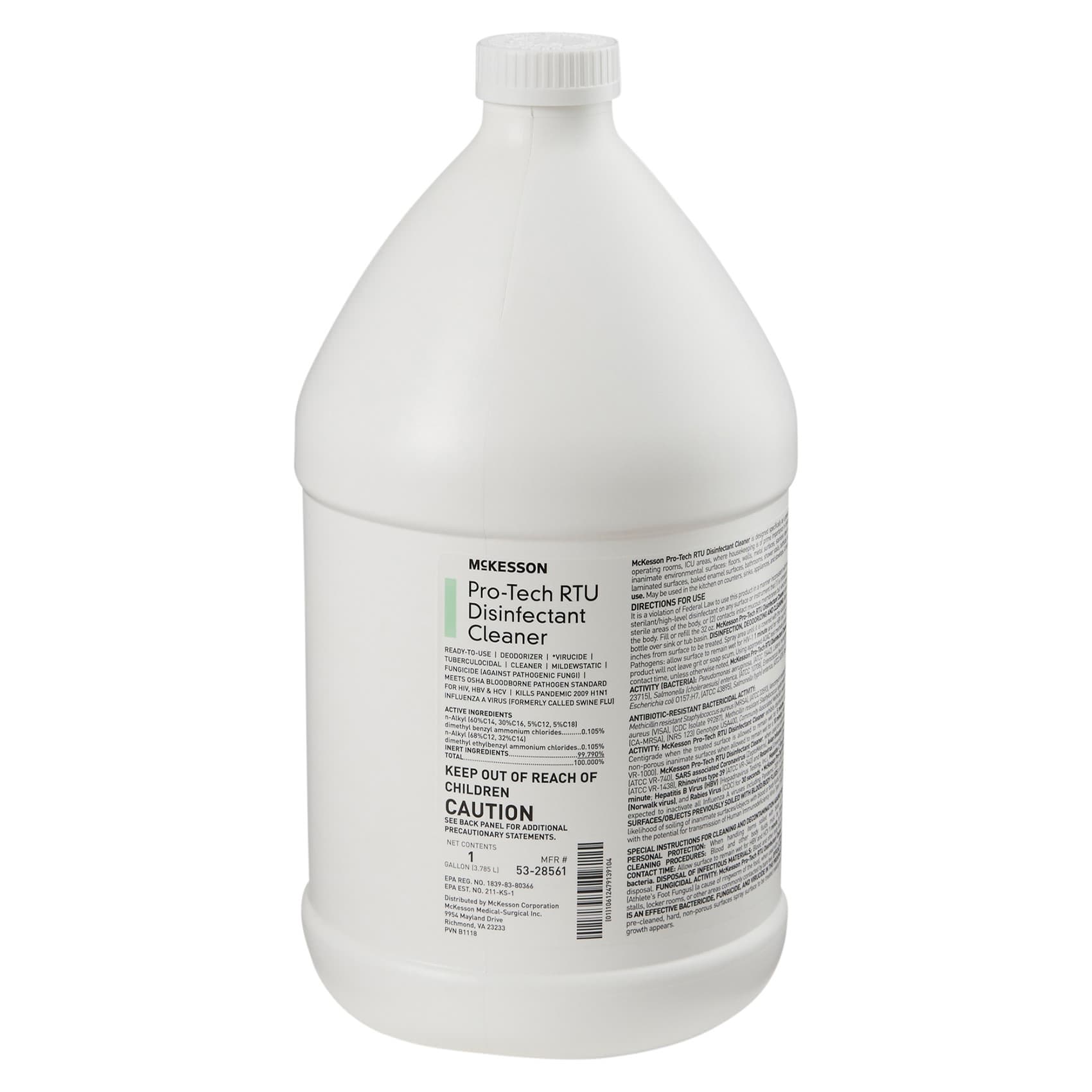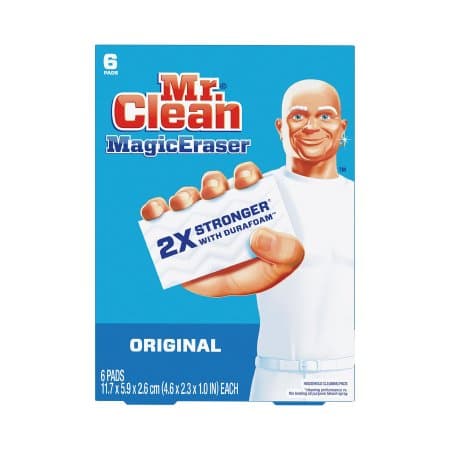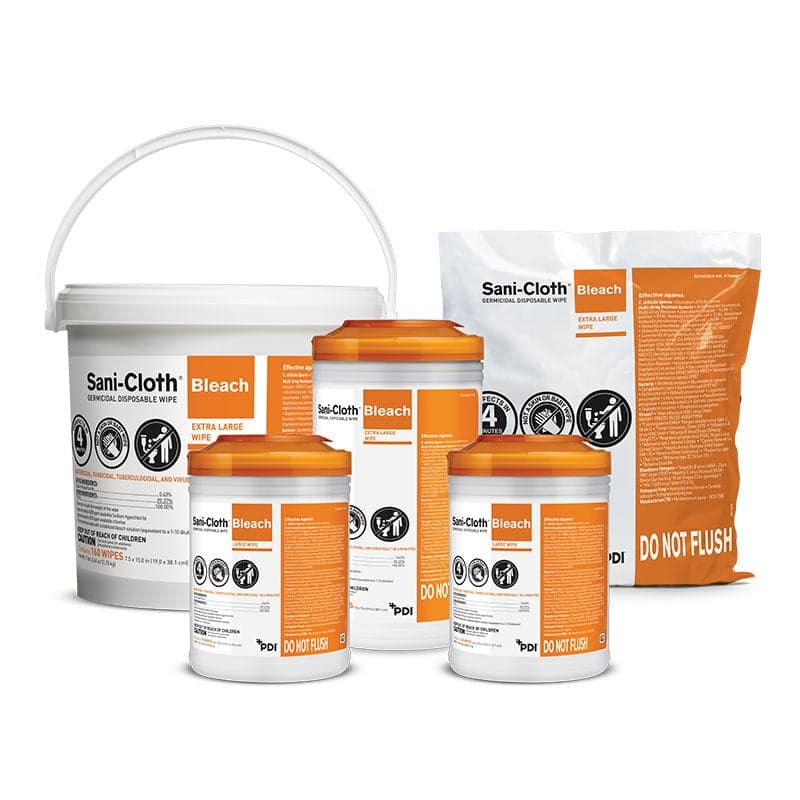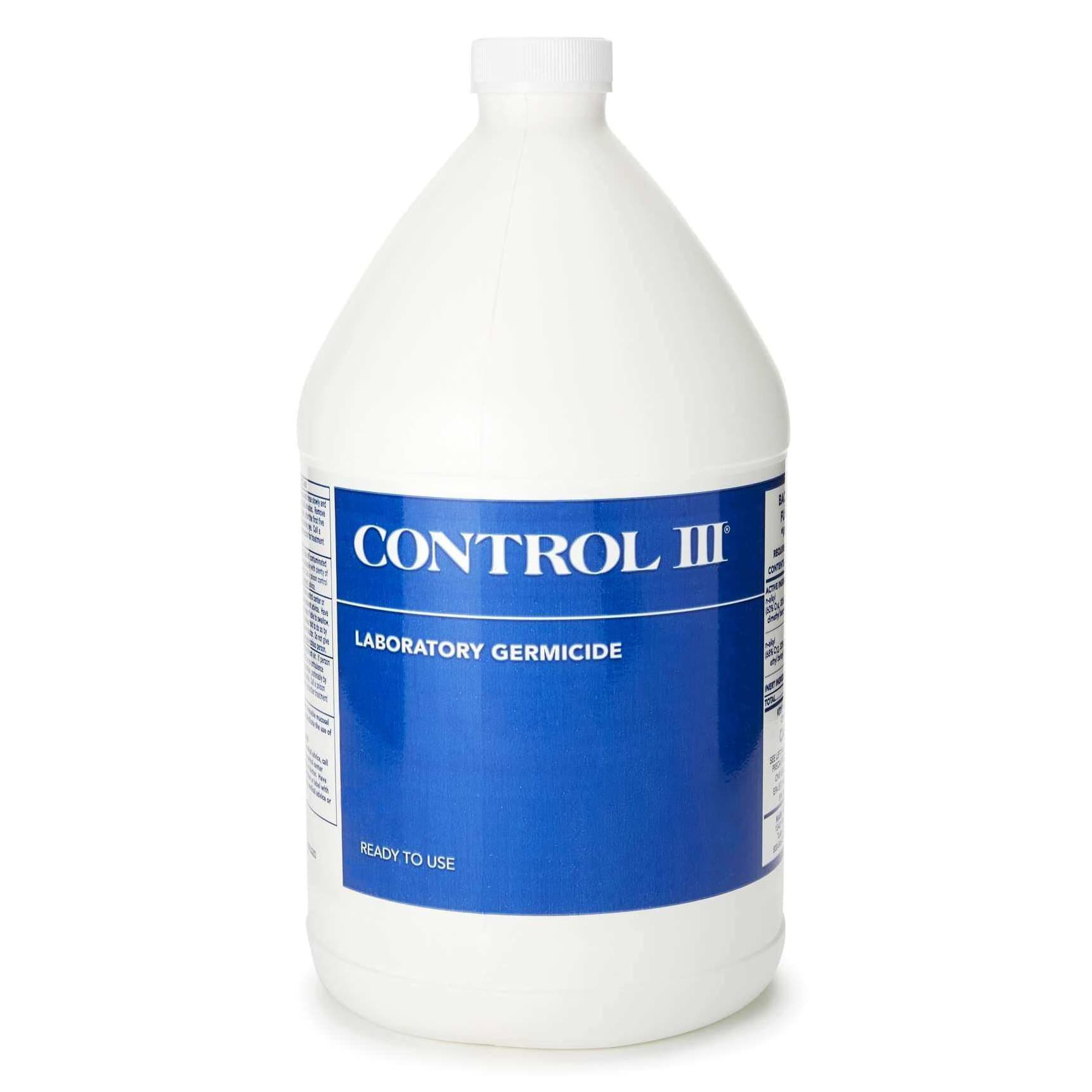
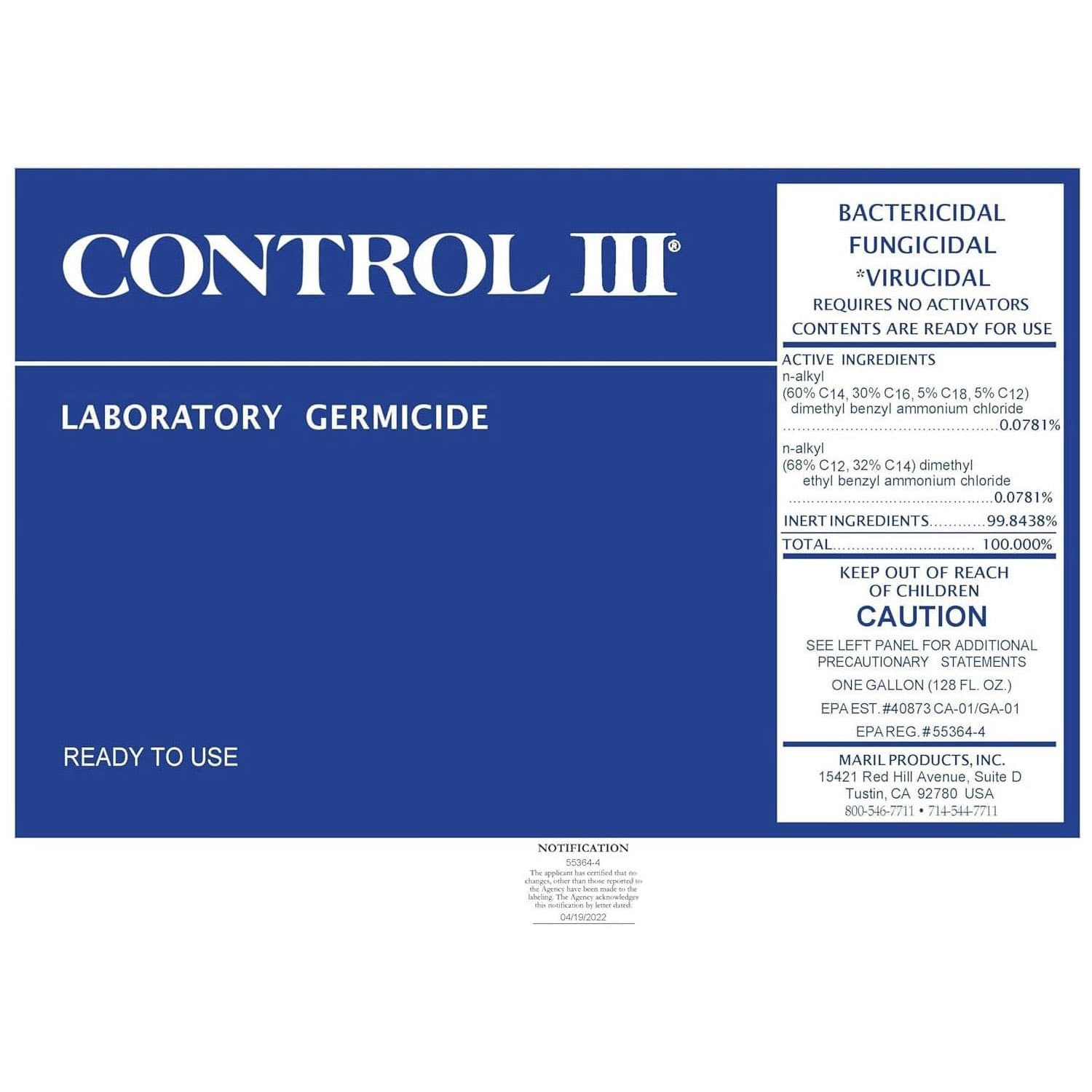
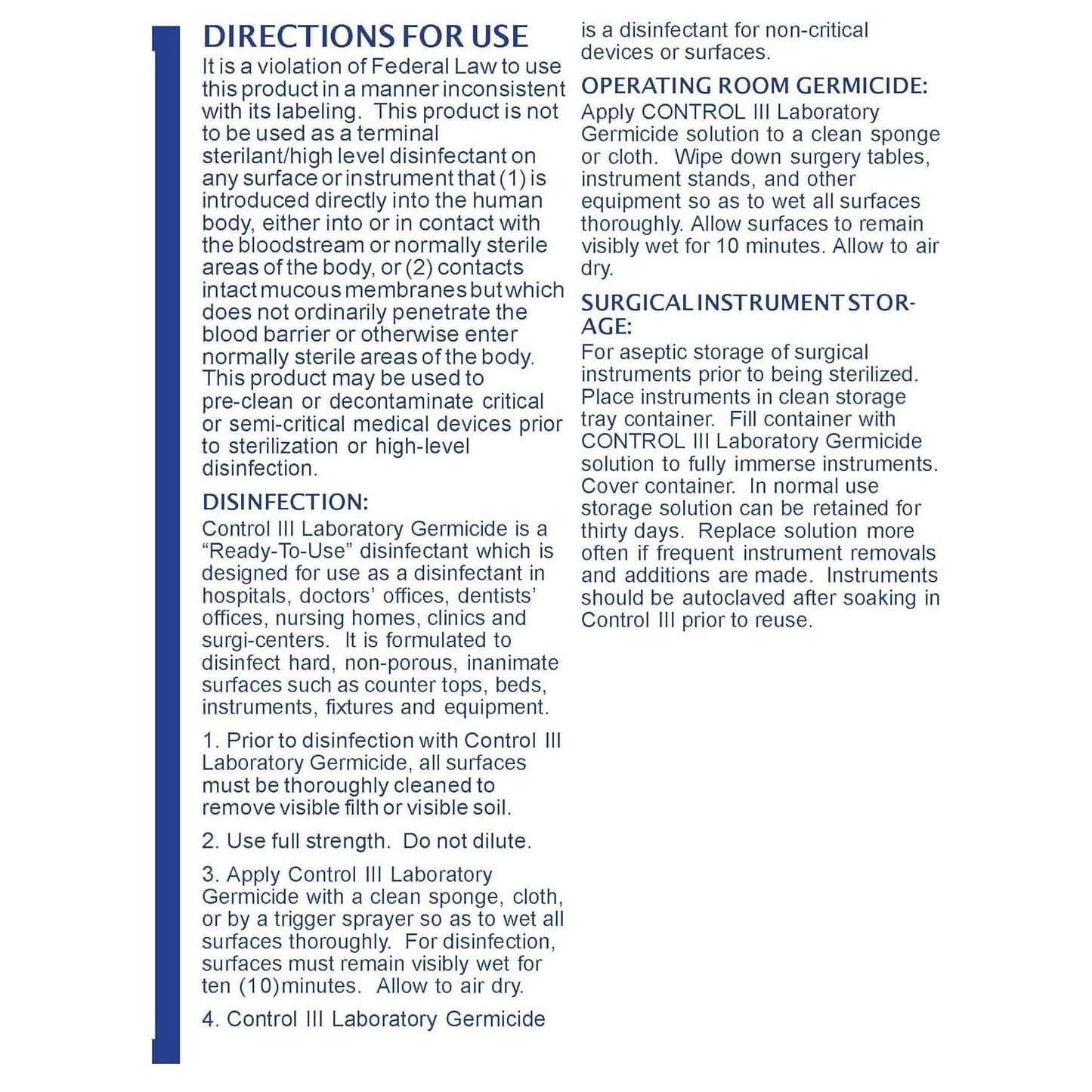
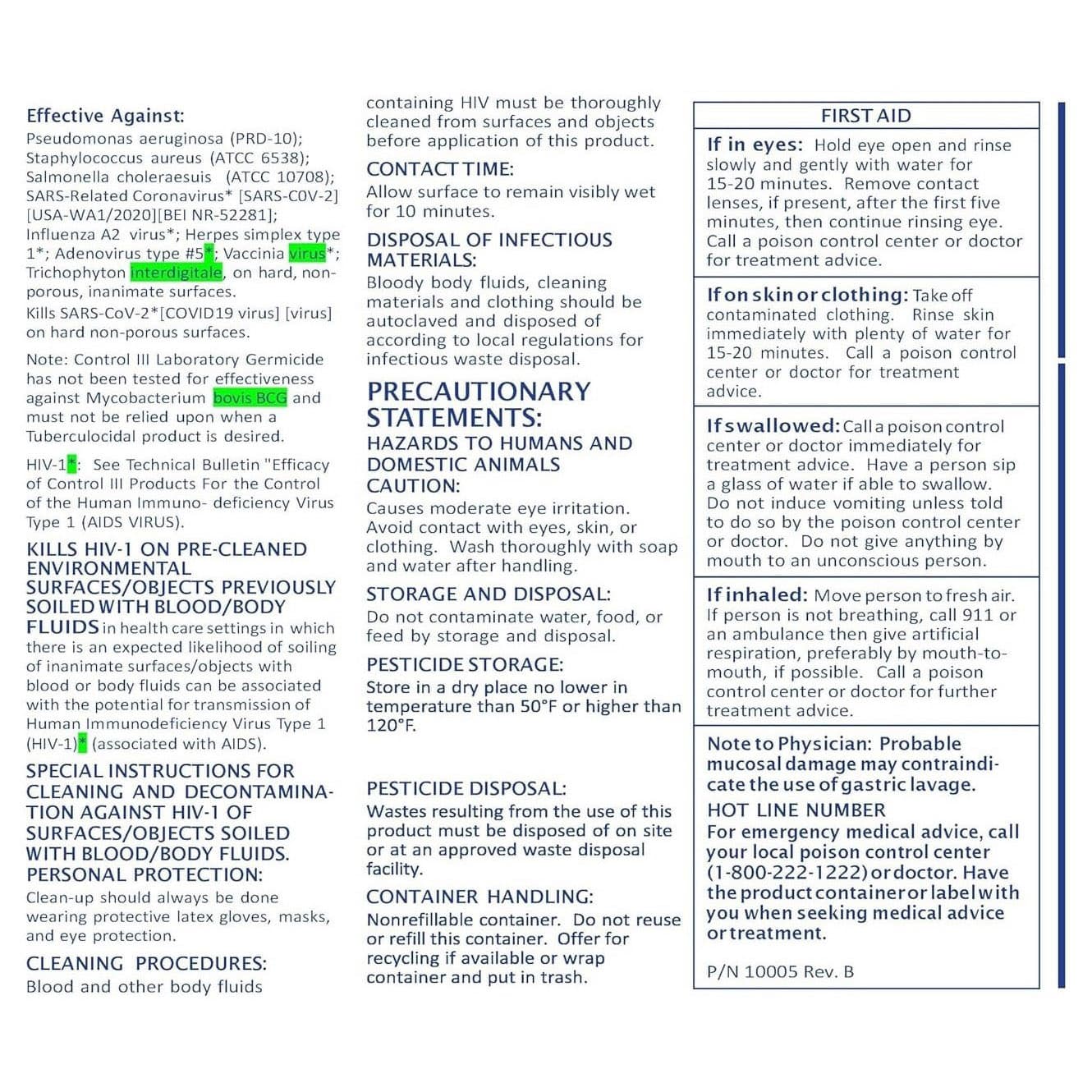
Control III Laboratory Germicide Surface Disinfectant Cleaner
Starts From
Description
Control III Laboratory Germicide is a ready-to-use, EPA-approved disinfectant designed for effective cleaning and disinfection in medical, institutional, and residential settings. It is non-toxic, non-corrosive, and formulated for a wide variety of surfaces and applications, offering comprehensive protection against bacteria, viruses, and fungi.
Features:
- Volume: 1 Gallon [128 oz]
- Cost-Effective: EPA-approved for reuse for up to 30 days.
- Environmentally Friendly: Pleasant odor and easy disposal.
- Ready-to-Use Convenience: No mixing, measuring, or activation required.
- Residual Protection: Bacteriostatic film offers longer-lasting disinfecting action.
- Non-Corrosive Formula: Safe for use on rubber, plastic, metal, and fiber optics. Safe to use with delicate EKG/EEG leads. Contains a rust inhibitor.
Effective Against:
- Pseudomonas aeruginosa
- Staphylococcus aureus
- Salmonella choeleraesuis
- Influenza A2 virus
- Herpes simplex type 1
- Adenovirus type #5
- Vaccinia viruses
- Trichophyton mentagrophytes
- HIV-1
Applications:
- Instruments and Surfaces: Suitable for blades, probes, catheters, scissors, forceps, clippers, floors, walls, chairs, examination tables, leads, desks, and toys.
- Durable Medical Equipment: Ideal for bed frames, wheelchairs, walkers, pumps, traction equipment, whirlpools, bedpans, exercise equipment, and monitors.
- Respiratory Equipment: Effective on mouthpieces, tracheal devices, CPR resuscitators, resuscitation mannequins, CPAP/BiPAP equipment, and ventilator equipment.
Directions for Use:
- Preparation: Control III is pre-mixed and ready to use. No further dilution is necessary.
- Application: Apply to hard, non-porous surfaces using a cloth, sponge, or sprayer.
- Contact Time: Ensure treated surfaces remain wet for a minimum of 10 minutes to achieve full disinfection.
- Reusability: The solution can be reused for up to 30 days if stored properly and uncontaminated.
Warranty
- The product warranty is applicable as per the terms and conditions provided by the product manufacturer.
Please call us for specific details.
Return
- No returns will be accepted after 30 days from the date of shipment.
- All returns are subject to a restocking fee as per manufacturers terms and conditions.
- All returns must have an RGA number (Returned Goods Authorization), unauthorized returns will not be accepted.
- We do not guarantee fulfillment of any desired purpose or product suitability to the user and this will not be considered as a valid reason for return.
- The products must be new, unused condition, not tampered with, in original packaging and returned at the customers expense in the original packaging.
- If your return is not due to any manufacturing defect then the original shipping cost will be deducted from the total refund.
- Hygiene, bath and toilet items cannot be returned once opened or used.
- Standard manufacturer terms and conditions apply for return policy of this product.
Please call us for specific details.
FAQs
Frequently Asked Questions:
Q. How does CONTROL III Laboratory Germicide compare to glutaraldehyde-based products?
A. Glutaraldehyde-based products contain toxic aldehyde derivatives, while CONTROL III Laboratory Germicide is a non-toxic double quaternary ammonium compound. Glutaraldehyde-based products are often used as terminal sterilants, when it is important that the surface be completely sterilized before use. 30 minutes of complete contact with a glutaraldehyde solution is normally required for terminal sterilization. CONTROL III Laboratory germicide, on the other hand is a disinfectant product and it is selected when the user does not require terminal sterilization.
Because glutaraldehyde-based products are such high level sterilants, they are quite toxic, and extreme care must be taken to use the appropriate gloves and hoods when using the products. They are also potentially harmful to the environment, and special steps must be taken to dispose of the products safely. In addition, their toxic nature may also reduce the useful life of the products they sterilize.
CONTROL III Laboratory Germicide does not require the use of gloves and hoods when being used. It is pleasant smelling, and environmentally friendly. It can be disposed of simply by pouring it down the drain.
Q. Do aldehydes, glutaraldehydes, and EtO gas leave a toxic residue in porous materials?
A. Yes. The residual concentration is dependent on the thoroughness of the water rinse (or outgassing, for EtO), the porousness of the materials, and clinging affinity of the germicide to the particular material.
Q. How long can CONTROL III Laboratory Germicide be used?
A. CONTROL III Laboratory Germicide has a concentration of 1560 parts per million (PPM), which is 3 times the amount required to kill bacteria. It would take 2-3 months for the dilution from the pre-cleaning rinse water to reduce the concentration below the bactericidal level of 550 PPM required to kill P. aeruginosa. It is recommended that CONTROL III Laboratory Germicide solution be discarded after every 30 days of use.
Q. Are test strips necessary to test the concentration of CONTROL III Laboratory Germicide?
A. No, but test strips provide a quantifiable means of ensuring that the solution of CONTROL III Laboratory Germicide is of sufficient strength to kill organisms. They are useful to confirm solution activity.
Q. What is the recommended soak time for CONTROL III Laboratory Germicide?
A. Ten minutes is the soak time required by the EPA approved label. However, soak periods of more than ten minutes will not necessarily provide better disinfection. Extensive soak periods may cause surface tackiness on a minimal number of certain PVC parts.
Q. What type of container should be used for soaking?
A. Polyethylene plastic buckets of food-grade plastic containers are recommended for soaking. This is the type of material used in our bottles. Do not use a polyvinylchloride (PVC) container, as it may become tacky after use with CONTROL III.
Q. Does hot or cold water affect CONTROL III Laboratory Germicide?
A. CONTROL III Laboratory Germicide is effective in either hot or cold water. Its effectiveness however, increases with a higher water temperature.
Q. How is CONTROL III Laboratory Germicide (pre-mixed and ready to use) different from CONTROL III Laboratory Germicide (concentrate)?
A. Control III Laboratory Germicide was formulated for use in hospitals and physician offices. It is effective for twice as long as Control III Disinfectant Germicide. Control III Disinfectant Germicide concentrate is specially designed for home care patients. It does not include rust inhibitors or a synergizing agent, and does not contain the other special additives and high-purity water that makes Control III Laboratory Germicide last longer. After dilution, Control III Disinfectant Germicide Concentrate can be used for 14 days. Once poured from the bottle and stored in a covered container, Control III Laboratory Germicide can be used for 30 days.
Q. How can CONTROL III Laboratory Germicide kill bacteria if it is relatively non-toxic?
A. Toxicity does not determine bactericidal effectiveness. CONTROL III Laboratory Germicide attacks the cytoplasm and nucleus of a bacterium by a chemical process while maintaining a low toxicity level.
Q. Can a water rinse be used after disinfection?
A. There are certain respiratory therapy equipment parts that may not tolerate a residue from any germicide. A tap water rinse can contaminate the disinfected items with hydrophilic bacteria, such as Psuedomonas aeruginosa. The answer is to rinse these parts with sterile water. However, if a tap water rinse is to be used, please advise your patients and clients to run hot water through the faucet for at least 3 minutes. This will help control the Pseudomonas that collects around the faucet orifice. Bottled sterile water should be used if available.
Q. How can excessive CONTROL III Laboratory Germicide be removed from plastic and metal equipment and parts?
A. A thorough water rinse will remove excess residual. If necessary, an anionic surfactant will neutralize the CONTROL III Laboratory Germicide, but not necessarily remove all the residual. It is best to use an alcohol for this purpose, such as Isopropyl alcohol, then rinse thoroughly with water.
Q. Is there an adverse reaction between CONTROL III Laboratory Germicide and an ethylene oxide (EtO) gas residual?
A. The general consensus is that there is no adverse reaction between CONTROL III Laboratory Germicide and EtO residual. This should not be a problem if sufficient outgassing is accomplished before the use of CONTROL III Laboratory Germicide.
Q. Is there any adverse reaction between CONTROL III Laboratory Germicide and a glutaraldehyde residual, which may remain on parts or equipment?
A. Again, the general consensus is that no adverse reaction would result. If there is a significant glutaraldehyde residual, it may be removed with ethanol.
Description
Control III Laboratory Germicide is a ready-to-use, EPA-approved disinfectant designed for effective cleaning and disinfection in medical, institutional, and residential settings. It is non-toxic, non-corrosive, and formulated for a wide variety of surfaces and applications, offering comprehensive protection against bacteria, viruses, and fungi.
Features:
- Volume: 1 Gallon [128 oz]
- Cost-Effective: EPA-approved for reuse for up to 30 days.
- Environmentally Friendly: Pleasant odor and easy disposal.
- Ready-to-Use Convenience: No mixing, measuring, or activation required.
- Residual Protection: Bacteriostatic film offers longer-lasting disinfecting action.
- Non-Corrosive Formula: Safe for use on rubber, plastic, metal, and fiber optics. Safe to use with delicate EKG/EEG leads. Contains a rust inhibitor.
Effective Against:
- Pseudomonas aeruginosa
- Staphylococcus aureus
- Salmonella choeleraesuis
- Influenza A2 virus
- Herpes simplex type 1
- Adenovirus type #5
- Vaccinia viruses
- Trichophyton mentagrophytes
- HIV-1
Applications:
- Instruments and Surfaces: Suitable for blades, probes, catheters, scissors, forceps, clippers, floors, walls, chairs, examination tables, leads, desks, and toys.
- Durable Medical Equipment: Ideal for bed frames, wheelchairs, walkers, pumps, traction equipment, whirlpools, bedpans, exercise equipment, and monitors.
- Respiratory Equipment: Effective on mouthpieces, tracheal devices, CPR resuscitators, resuscitation mannequins, CPAP/BiPAP equipment, and ventilator equipment.
Directions for Use:
- Preparation: Control III is pre-mixed and ready to use. No further dilution is necessary.
- Application: Apply to hard, non-porous surfaces using a cloth, sponge, or sprayer.
- Contact Time: Ensure treated surfaces remain wet for a minimum of 10 minutes to achieve full disinfection.
- Reusability: The solution can be reused for up to 30 days if stored properly and uncontaminated.
Warranty
- The product warranty is applicable as per the terms and conditions provided by the product manufacturer.
Please call us for specific details.
Return
- No returns will be accepted after 30 days from the date of shipment.
- All returns are subject to a restocking fee as per manufacturers terms and conditions.
- All returns must have an RGA number (Returned Goods Authorization), unauthorized returns will not be accepted.
- We do not guarantee fulfillment of any desired purpose or product suitability to the user and this will not be considered as a valid reason for return.
- The products must be new, unused condition, not tampered with, in original packaging and returned at the customers expense in the original packaging.
- If your return is not due to any manufacturing defect then the original shipping cost will be deducted from the total refund.
- Hygiene, bath and toilet items cannot be returned once opened or used.
- Standard manufacturer terms and conditions apply for return policy of this product.
Please call us for specific details.
FAQs
Frequently Asked Questions:
Q. How does CONTROL III Laboratory Germicide compare to glutaraldehyde-based products?
A. Glutaraldehyde-based products contain toxic aldehyde derivatives, while CONTROL III Laboratory Germicide is a non-toxic double quaternary ammonium compound. Glutaraldehyde-based products are often used as terminal sterilants, when it is important that the surface be completely sterilized before use. 30 minutes of complete contact with a glutaraldehyde solution is normally required for terminal sterilization. CONTROL III Laboratory germicide, on the other hand is a disinfectant product and it is selected when the user does not require terminal sterilization.
Because glutaraldehyde-based products are such high level sterilants, they are quite toxic, and extreme care must be taken to use the appropriate gloves and hoods when using the products. They are also potentially harmful to the environment, and special steps must be taken to dispose of the products safely. In addition, their toxic nature may also reduce the useful life of the products they sterilize.
CONTROL III Laboratory Germicide does not require the use of gloves and hoods when being used. It is pleasant smelling, and environmentally friendly. It can be disposed of simply by pouring it down the drain.
Q. Do aldehydes, glutaraldehydes, and EtO gas leave a toxic residue in porous materials?
A. Yes. The residual concentration is dependent on the thoroughness of the water rinse (or outgassing, for EtO), the porousness of the materials, and clinging affinity of the germicide to the particular material.
Q. How long can CONTROL III Laboratory Germicide be used?
A. CONTROL III Laboratory Germicide has a concentration of 1560 parts per million (PPM), which is 3 times the amount required to kill bacteria. It would take 2-3 months for the dilution from the pre-cleaning rinse water to reduce the concentration below the bactericidal level of 550 PPM required to kill P. aeruginosa. It is recommended that CONTROL III Laboratory Germicide solution be discarded after every 30 days of use.
Q. Are test strips necessary to test the concentration of CONTROL III Laboratory Germicide?
A. No, but test strips provide a quantifiable means of ensuring that the solution of CONTROL III Laboratory Germicide is of sufficient strength to kill organisms. They are useful to confirm solution activity.
Q. What is the recommended soak time for CONTROL III Laboratory Germicide?
A. Ten minutes is the soak time required by the EPA approved label. However, soak periods of more than ten minutes will not necessarily provide better disinfection. Extensive soak periods may cause surface tackiness on a minimal number of certain PVC parts.
Q. What type of container should be used for soaking?
A. Polyethylene plastic buckets of food-grade plastic containers are recommended for soaking. This is the type of material used in our bottles. Do not use a polyvinylchloride (PVC) container, as it may become tacky after use with CONTROL III.
Q. Does hot or cold water affect CONTROL III Laboratory Germicide?
A. CONTROL III Laboratory Germicide is effective in either hot or cold water. Its effectiveness however, increases with a higher water temperature.
Q. How is CONTROL III Laboratory Germicide (pre-mixed and ready to use) different from CONTROL III Laboratory Germicide (concentrate)?
A. Control III Laboratory Germicide was formulated for use in hospitals and physician offices. It is effective for twice as long as Control III Disinfectant Germicide. Control III Disinfectant Germicide concentrate is specially designed for home care patients. It does not include rust inhibitors or a synergizing agent, and does not contain the other special additives and high-purity water that makes Control III Laboratory Germicide last longer. After dilution, Control III Disinfectant Germicide Concentrate can be used for 14 days. Once poured from the bottle and stored in a covered container, Control III Laboratory Germicide can be used for 30 days.
Q. How can CONTROL III Laboratory Germicide kill bacteria if it is relatively non-toxic?
A. Toxicity does not determine bactericidal effectiveness. CONTROL III Laboratory Germicide attacks the cytoplasm and nucleus of a bacterium by a chemical process while maintaining a low toxicity level.
Q. Can a water rinse be used after disinfection?
A. There are certain respiratory therapy equipment parts that may not tolerate a residue from any germicide. A tap water rinse can contaminate the disinfected items with hydrophilic bacteria, such as Psuedomonas aeruginosa. The answer is to rinse these parts with sterile water. However, if a tap water rinse is to be used, please advise your patients and clients to run hot water through the faucet for at least 3 minutes. This will help control the Pseudomonas that collects around the faucet orifice. Bottled sterile water should be used if available.
Q. How can excessive CONTROL III Laboratory Germicide be removed from plastic and metal equipment and parts?
A. A thorough water rinse will remove excess residual. If necessary, an anionic surfactant will neutralize the CONTROL III Laboratory Germicide, but not necessarily remove all the residual. It is best to use an alcohol for this purpose, such as Isopropyl alcohol, then rinse thoroughly with water.
Q. Is there an adverse reaction between CONTROL III Laboratory Germicide and an ethylene oxide (EtO) gas residual?
A. The general consensus is that there is no adverse reaction between CONTROL III Laboratory Germicide and EtO residual. This should not be a problem if sufficient outgassing is accomplished before the use of CONTROL III Laboratory Germicide.
Q. Is there any adverse reaction between CONTROL III Laboratory Germicide and a glutaraldehyde residual, which may remain on parts or equipment?
A. Again, the general consensus is that no adverse reaction would result. If there is a significant glutaraldehyde residual, it may be removed with ethanol.
Starts From




